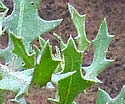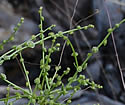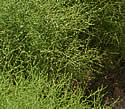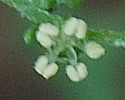Cycloloma atriplicifolium (Winged Pigweed)
| Also known as: | |
|---|---|
| Genus: | Cycloloma |
| Family: | Amaranthaceae (Amaranth) |
| Life cycle: | annual |
| Origin: | native |
| Habitat: | sun; dry sandy soil; disturbed or waste places, roadsides, fields |
| Bloom season: | July - August |
| Plant height: | 6 to 20 inches |
| Wetland Indicator Status: | GP: FACU MW: FACU NCNE: FACU |
| MN county distribution (click map to enlarge): |  |
| National distribution (click map to enlarge): |  |
Pick an image for a larger view. See the glossary for icon descriptions.
Detailed Information
Flower: 



![[photo of flower]](/udata/r9ndp23q/pd/cycloloma-atriplicifolium-10-t.jpg) Flowers are very small, green and indistinct, 1/10 inch across, widely spaced in open, diffusely branched spikes. Flowers are either perfect (both ♂ & ♀ parts present) or pistillate (just ♀). In perfect flowers, the 5 yellow-tipped stamens are the most visual component, the 5-parted calyx curving in over the flattened ovary in the center.
Flowers are very small, green and indistinct, 1/10 inch across, widely spaced in open, diffusely branched spikes. Flowers are either perfect (both ♂ & ♀ parts present) or pistillate (just ♀). In perfect flowers, the 5 yellow-tipped stamens are the most visual component, the 5-parted calyx curving in over the flattened ovary in the center.
Leaves and stems: 


![[photo of leaves]](/udata/r9ndp23q/yellow/winged-pigweed_0731_123531-t.jpg) Leaves are alternate, pale green, purpling with age, up to 3 inches long and to ¾ inch wide, withering away with maturity (deciduous). Leaves are generally lance shaped, with irregular, sharply pointed lobed-like teeth and narrowing at the base to a short stalk and becoming smaller as they ascend the stem. The shape is reminiscent of Christmas holly. The entire plant is covered in fine cobwebby hairs when young, becoming smooth with age. Stems have parallel lines, are somewhat angled, and are copiously branched.
Leaves are alternate, pale green, purpling with age, up to 3 inches long and to ¾ inch wide, withering away with maturity (deciduous). Leaves are generally lance shaped, with irregular, sharply pointed lobed-like teeth and narrowing at the base to a short stalk and becoming smaller as they ascend the stem. The shape is reminiscent of Christmas holly. The entire plant is covered in fine cobwebby hairs when young, becoming smooth with age. Stems have parallel lines, are somewhat angled, and are copiously branched.
Fruit: 
![[photo of fruits]](/udata/r9ndp23q/yellow/winged-pigweed_0731_122859-t.jpg) Fruits are round and flattened, black at maturity with a toothed, winged membrane (hence the common name) formed around the edges.
Fruits are round and flattened, black at maturity with a toothed, winged membrane (hence the common name) formed around the edges.
Notes:
Winged Pigweed is a scrappy plant of sand prairie and can become weedy in such places as abandoned industrial lots and pavement cracks along highways. An efficient "tumbleweed" species, the small taproot easily breaks free from the fine fiberous roots, sending the round, spidery top across an open landscape, scattering seed along the way.
Native Plant Nurseries, Restoration and Landscaping Services ↓
More photos
 Winged Pigweed plant
Winged Pigweed plant more plants
more plants Winged Pigweed at a construction site
Winged Pigweed at a construction site a sense of scale
a sense of scale Winged Pigweed in winter
Winged Pigweed in winter
Photos by K. Chayka taken in Ramsey County. Photos courtesy Peter M. Dziuk taken in Anoka and Ramsey counties.
Comments
Have you seen this plant in Minnesota, or have any other comments about it?
on: 2016-09-19 04:10:40
Saw small individuals of this plant in the dunes at Point Park, Duluth. The young fruits were quite red.
on: 2021-09-02 19:44:46
Seen these now along forest roads in Sand Dunes State Forest and in Uncas SE Unit in (always sandy) disturbed areas.






